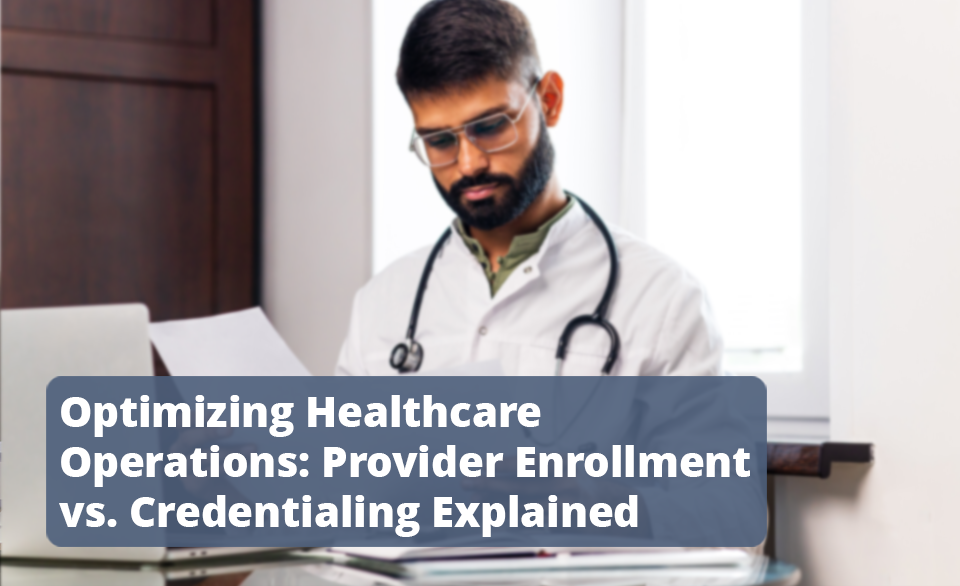Optimizing Healthcare Operations: Provider Enrollment vs. Credentialing Explained

Provider Enrollment vs. Credentialing
Healthcare organizations often use terms like provider enrollment and credentialing interchangeably; however, they serve different purposes in medical practice management. Understanding the distinction between the two is essential for optimizing operational efficiency and ensuring compliance.
Understanding Provider Enrollment
Provider enrollment refers to the process of registering a healthcare provider with insurance companies and public programs such as Medicare and Medicaid. This process involves submitting necessary documentation and information about the provider’s qualifications, practice locations, and services offered. It is vital for ensuring that the provider can bill for services rendered to patients covered by these insurance plans.
The enrollment process typically involves several steps, including:
| Step | Description |
|---|---|
| 1 | Gathering necessary documents such as licenses and tax information. |
| 2 | Completing enrollment applications for each payer. |
| 3 | Submitting the applications and ensuring all information is accurate. |
| 4 | Following up with payers to confirm the provider’s enrollment status. |
Healthcare organizations should prioritize maintaining up-to-date enrollment with each payer to minimize billing disruptions.
Understanding Credentialing
Credentialing is the process of verifying a healthcare provider’s qualifications and professional history, ensuring they meet the standards required by regulatory bodies, healthcare organizations, and payers. It includes a thorough assessment of the provider’s education, training, work history, and any disciplinary actions taken against them.
The credentialing process typically follows certain key steps:
| Step | Description |
|---|---|
| 1 | Collecting primary source verification documents, such as educational transcripts and specialty certifications. |
| 2 | Conducting background checks, including malpractice history and board certifications. |
| 3 | Reviewing and approving the collected information by a credentialing committee. |
| 4 | Updating the provider’s status regularly to account for changes in licensure or practice privileges. |
Credentialing is necessary for maintaining compliance with regulatory guidelines and ensuring patient safety.
In the evolving landscape of healthcare, understanding the distinctions between provider enrollment and credentialing is vital for healthcare professionals aiming to enhance revenue cycle management and compliance efficiency. By grasping both concepts, providers can improve their practice’s operational effectiveness and maintain the necessary standards to serve patients satisfactorily.
Key Differences and Importance
Understanding the distinctions between provider enrollment and credentialing is essential in optimizing healthcare operations. Each process serves a unique purpose but ultimately contributes to the smooth functioning of medical practices.
Role of Provider Enrollment
Provider enrollment refers to the process of registering a healthcare provider with insurance companies and government programs. This step is critical for enabling providers to receive reimbursement for their services. The enrollment process typically involves submitting necessary documentation and completing applications for each payer.
Key responsibilities in provider enrollment include:
| Task | Description |
|---|---|
| Application Submission | Completing forms required by various insurance payers. |
| Verification of Information | Ensuring accuracy in submitted data, including tax identification numbers and practice locations. |
| Follow-Up Communications | Engaging with payers to confirm successful enrollment and address potential issues. |
Effective management of provider enrollment can lead to improved cash flow and minimized claim denials.
Role of Credentialing
Credentialing is the process of verifying a provider’s qualifications, training, experience, and professional history. This step assures that the provider meets the standards set by healthcare organizations, insurance companies, and regulatory bodies. Credentialing typically focuses on a provider’s education, residency training, board certifications, and malpractice history.
Key aspects of credentialing include:
| Task | Description |
|---|---|
| Verification of Credentials | Thoroughly checking licenses, certifications, and educational background. |
| Ongoing Monitoring | Regular review of provider credentials to ensure ongoing compliance and quality assurance. |
| Re-Credentialing | Periodic re-evaluation of providers to maintain up-to-date credentials. |
Credentialing plays a vital role in maintaining patient safety and quality care.
How Provider Enrollment and Credentialing Interconnect
While provider enrollment and credentialing are distinct processes, they are interconnected in several ways. Both are essential for ensuring that healthcare providers can practice effectively within their networks.
| Aspect | Provider Enrollment | Credentialing |
|---|---|---|
| Objective | Enable reimbursement for services rendered | Ensure providers meet quality and safety standards |
| Documentation | Requires specific payer applications | Involves verification of credentials and qualifications |
| Compliance | Must be compliant with payer requirements for enrollment | Must comply with regulatory requirements and internal policies |
A well-coordinated approach to both provider enrollment and credentialing can lead to improved efficiencies and revenue cycle management. Exploring how these processes affect the overall healthcare landscape is crucial.





